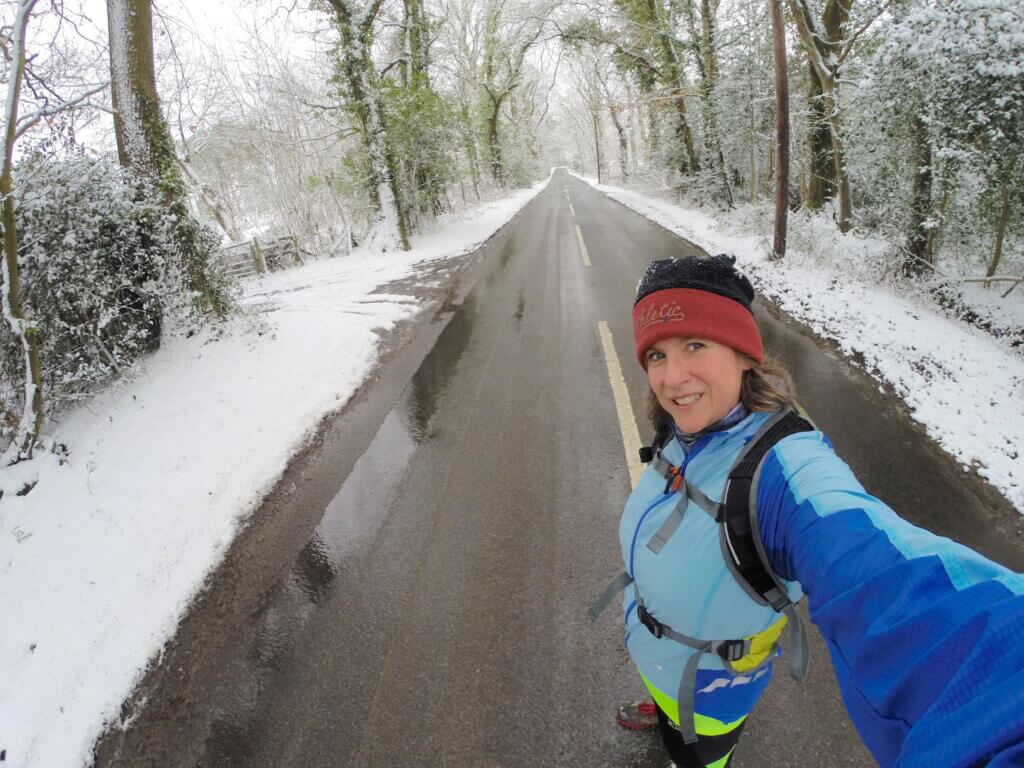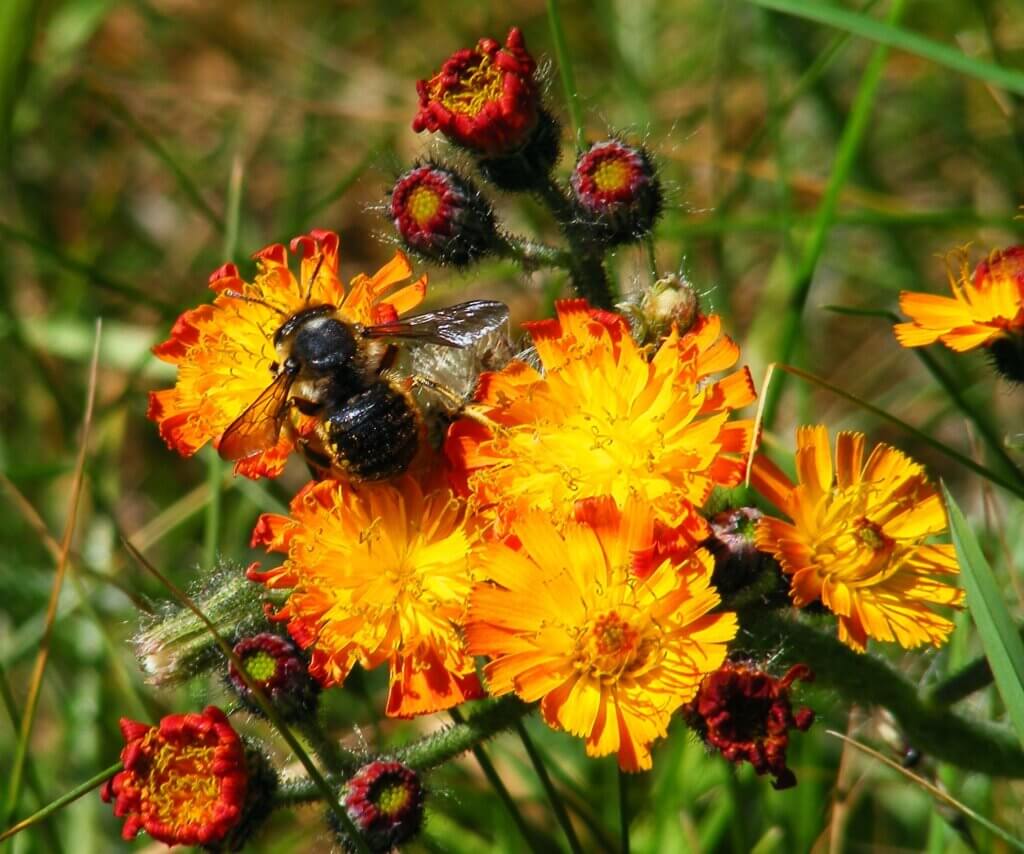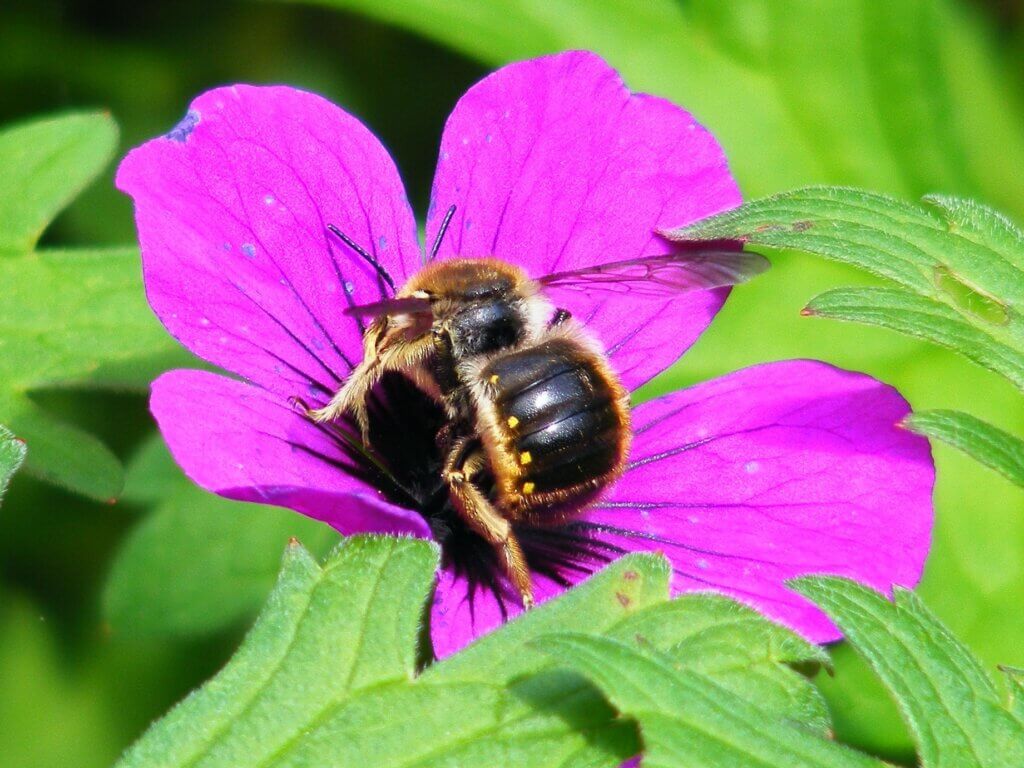
Jane is a naturalist, photographer and nature writer living in Dorset. Her work has appeared in books, anthologies and blogs for charities such as The Wildlife Trusts and the International Bee Research Association. When she’s not exploring Dorset’s lanes and countryside she can be found lying on her stomach watching insects in her garden. Jane’s entry for this blog’s Lockdown Nature-writing challenge was shortlisted and can be found by clicking here. Jane is currently studying for an MA in Travel and Nature Writing at Bath Spa University and can be found: www.janevadams.com and on Twitter @WildlifeStuff
Wool-carder bee

At first I ignored my friend when she said, “If you plant it, they will come”.
After months of reading about the Wool-carder Bee (Anthidium manicatum), learning what it looked like, the habitat it preferred and the female’s habit of collecting hairs from leaves to line her nest, I was still bemoaning the fact that I hadn’t seen one. My friend was getting frustrated.
“Just buy a bl**dy Lamb’s-ear and plant it in the garden. What have you got to lose?”
She was right, but I still thought the likelihood of a Wool-carder bee chancing upon my semi-urban garden was pretty low. But I humoured her, and on the 9th of June 2011 I tracked down a very hairy-leafed Lamb’s-ear (Stachys byzantina) at a local garden centre. Planted it, watered it, and waited.
I’m not sure why I waited. I wasn’t expecting anything to happen, so when a bee appeared one hour and forty-five minutes later, it didn’t initially register. Its almost hairless face was a brighter yellow than I’d expected, and it was chunkier than the one-dimensional photos in the books, buxom even.
We stared at each other. The bee on a leaf of the newly planted Lamb’s-ear, me leaning on my elbows awkwardly trying to crawl forwards on my stomach. With its head down and yellow-dashed abdomen hunched behind, it scraped downy silver-green hairs from the leaf with its mandibles, rolling them into a fluffy ball under its chin as it shuffled backwards. It was a female Wool-carder bee.
Then she was gone.
I watched her many times after that, sometimes feeding on the plant’s tiny pink flowers, collecting more ‘wool’ from the velvet leaves, sometimes mating with the even chunkier male. He had started to defend her plant from other male Wool-carder Bees, but his aggressive swipes on even the largest hoverflies and bumblebees were reckless to say the least. He was punching well above his weight.
The clump of Lamb’s-ear has spread, and more bees appear each year. I find myself waiting anxiously for them at the start of June, but still haven’t found out where they nest. No doubt they’re tucked away in a cavity nearby, lined with thousands of tiny hairs from my plants.
Maybe I need to build a bee nesting box with just the right sized holes for the female to squeeze into? I should stop procrastinating.
“If I build it, they will come”.

Wool-carder Bee (Anthidium manicatum) fact file
Roughly the size of a honeybee, but chunkier. Male bigger than females. Yellow markings on face and yellow spots/dashes down the side of a dark coloured abdomen. Seen from June to August. Common in southern England and south coast of Wales. Scarcer elsewhere in the UK. No sting but the male has a set of spikes on his tail that he uses to guard a patch of flowers for female suitors, sometimes killing insect intruders. Nests in existing holes, including wood, hollow stems and man-made objects. Feeds on many flowers including Lamb’s-ear, Bird’s-foot Trefoil and Orange Hawkbit. Female cards hairs from plants such as Lamb’s-ear and Great Mullein.

I used to get loads here on my lamb’s ear but for the last two years the sparrows have ripped the plants to pieces for nesting material and left none for the bees. I put out loads of nesting material for the birds but they must either need very big nests or stachys has some other property that makes it desirable.
Dave – it’s interesting you should notice that as I was reading the other day that the female Wool-carder bee also scrapes exuded substances from the leaves of Lamb’s-ear with special brushes on her legs. She then uses it to line the nest cell prior to adding the hairs possibly for the purpose of protecting the nest from parasitic wasps. I wonder if the sparrows have found a use for these substances too!
Our sparrows leave the Great Mullein alone and it’s a cracking plant anyway. Maybe give that a try.
Nice blog Jane.
Thanks Paul – much appreciated. Yes, Great Mullein is a fantastic plant, any of the ‘hairy’ mulleins would be worth trying, they also flower for ages and don’t mind dry sandy soil (which is what I have here on the edge of the heathland).
Great pic of what looks like Ann Folkard obscured by a splendidly hairy bee! I spotted a couple of not-yet-flowering Gert Mulleins last night in dry chalky soil on top of a chalk escarpment while looking for more materiel while Mrs C busily shovelled llama dung into a bucket. There were some colonies of Rock Rose but there were no bees or anything else. While the garden is full of bees it hasn’t reached Peak Bumble – no Marjoram in flower yet – but there are solitary ones on Field Geraniums. As much of what used to be my veg patch have been taken over by Dog Daisy I have been hoping for some bee-ish compensation but No! Seems bees don’t like ’em at all at all and I had begun to wonder whether they contain some insect repellant that made them repellent to bees as according to Old Wives head lice don’t like them. A closer look today still showed avoidance by big bees but there were a few very small blackish ones about 10mm long visiting them with loads of pollen in their baskets. However this may not be sufficient reason for the Dog Daisies to stay as these are Hard Times and with rapidly declining disposable income home-grown organic beetroot may become essential because alas Gardening for Nature means we have no food and frankly there’s only so much Rhubarb a person can eat.
Thanks, yes you could be right, having looked it up on the RHS site it could well be Ann Folkard, a great cranesbill geranium. It grows like a weed in my garden, I’m forever pulling bits up to make way for other plants. I’m not sure about the Rock Rose but the Dog Daisy (Oxeye?) is definitely visited by quite a few species of insect. I’ve just checked in my copy of “Plants for bees” (an excellent book if you ever get the chance to pick up a copy) and it says “The open flower makes the nectar accessible to a wide range of bees, including short-tongued bumblebees and a variety of solitary bees, such as mining bees (Andrena, Colletes and Halictus species) and some small, black stem-nesting bees (Hylaeus species). I wouldn’t be surprised if what you saw were Halictus sp. (as I think Hylaeus sp. carry pollen back to the nest in their crop). However, for a garden, I agree with you – I think there are better plants for bees – I personally love any of the mint family and cranesbills, and even my runner beans and tomatoes get constant visits from the bumblebees. However, I disagree about the rhubarb – I don’t think you can ever have too much rhubarb!
Jane – quite right – you can never have too much rhubarb!
I envy you. They are fantastic bees to watch. I first saw them in Helmsley, North Yorkshire (which is quite a northerly record) wizzing around a patch of Lamb’s ear. I’ve been looking out for them since but not very successfully. I have seen one in my North Yorkshire village of Hunmanby but that’s all. I keep looking in people’s front gardens for Lamb’s ear but it doesn’t seem a very popular plant here.
You’re right Paul – Lamb’s-ear seems to have fallen out of fashion. I had to hunt around for mine, and did manage to pick it up at a nursery (but only because the owner had a massive plant in her private garden, and went and dug up part of it for me). Saying that, since 2011 I have seen it occasionally at independent nurseries, but they don’t seem to hold many plants. Hope you get lucky this year.